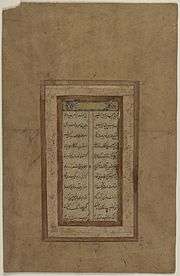Sidrat al-Muntaha
The Sidraṫ al-Munṫahā (Arabic: سِـدْرَة الْـمُـنْـتَـهَى; lit. "Lote-Tree of the Utmost Farthest Boundary") is a large enigmatic lote tree or Sidr tree[1] that marks the end of the seventh heaven, the boundary which no creation can pass, according to Islamic beliefs. During the Isra and Mi'raj, Muhammad, being the only one allowed, traveled with the archangel Gabriel to the tree (where the angel stopped) beyond which it is said that God assigned the five daily prayers.[2]


In other religions
The Sidrat al-Muntahā (usually transcribed as Sadratu'l-Muntahá in writings of the Baháʼí faith; see Baháʼí orthography) is a metaphor for the Manifestation of God.[10][11][12]
Use as a symbol
The lote-tree is used as a symbol, for example, by the Qatar Foundation: "The Sidra tree, growing strong and proud in the harshest of environments, has been a symbol of perseverance and nourishment across the borders of the Arab world. What is the significance of this glorious tree? With its roots bound in the soil of this world and its branches reaching upwards toward perfection, it is a symbol of solidarity and determination; it reminds us that the goals of this world are not incompatible with the goals of the spirit." The evergreen tree Ziziphus spina-christi represents this symbol in natural form.[13]
See also
References
- Quran 53:14
- El-Sayed El-Aswad. Religion and Folk Cosmology: Scenarios of the Visible and Invisible in Rural Egypt. Praeger/Greenwood. United States: 2002. p. 84. ISBN 0-89789-924-5
- Stephen Lambden (9 November 2009). "The Sidrah (Lote-Tree) and the Sidrat al-Muntaha (Lote-Tree of the Extremity) - part 1". Hurqalya Publications. Archived from the original on 9 November 2013. Retrieved 9 July 2014.
- Mohammed, Khaleel (Spring 2005). "Assessing English Translations of the Qur'an". Middle East Quarterly. Middle East Forum. 12 (2): 58–71. Retrieved 22 Oct 2015.
- Abdullah, Yusuf Ali (1946) The Holy Qur-an: Text, Translation and Commentary, Qatar National Printing Press. p.1139,n.3814
- Sale, George (n.d.) The Koran" Sir John Lubbock's hundred books. George Routledge and sons, London. p.323 note r
- Ahmad al-Badawi, p. 323 note 1
- Rumi' p. 323' note 2
- Burton, Richard Francis (1855). "A Personal Narrative of a Pilgrimage to Al-Madinah and Meccah". Project Gutenberg. p. 337. Retrieved 8 July 2016.
- Macias, Shirley: Verse of Light, the Sadratu'l-Muntahá, and the Unfoldment of Allah's Plan, The (1991)
- Lambden, Stephen. (2009). The Sidrah (Lote-Tree) and the Sidrat al-Muntaha (Lote-Tree of the Extremity): Some Apects of their Islamic and Bābī-Bahā'ī Interpretations - In Two Parts.
- Taherzadeh, Adib (1976). The Revelation of Baháʼu'lláh, Volume 1: Baghdad 1853-63. Oxford, UK: George Ronald. pp. 82–83. ISBN 0-85398-270-8.
- Sheikha Moza bint Nasser, Qatar Foundation Chairperson (13 October 2003). "The Sidra Tree Story". Qatar Foundation - About.
- Ayoub, Mahmoud. The Qur'an and Its Interpreters: The House of 'Imran. SUNY Press. Albany, NY: 1992. ISBN 0-7914-0993-7